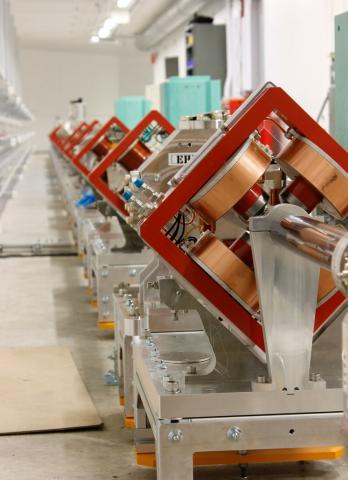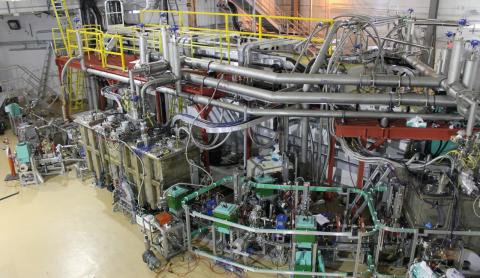

Over the past year, the installation and commissioning of the ARIEL superconducting electron linear accelerator (e-linac) has commanded the attention of the laboratory. Housed in the Electron (formerly Proton) Hall, the e-linac accelerates an electron beam to high energy that must be then transported along a precisely laid beam line to the adjacent ARIEL building. There, the beam will meet target stations and produce isotopes.
With astonishing speed, the beam line was installed in the ARIEL tunnel. Tunnel cable trays and beam line stands were assembled, beam line equipment such as quadrupole magnets, diagnostic boxes, and vacuum pipes were mounted to support brackets, and beam line sections were aligned to sub-millimetre precision in the tunnel between ARIEL and the Electron Hall (E-Hall). Funded by the Canadian Foundation for Innovation, this new beam line was completed right on schedule.
Key advances, as well as skillfully designed and engineered plans, were instrumental in successfully driving the beam line forward. E-Linac Project Lead Shane Koscielniak remarked, “The rapidity with which beam line components have been installed at precisely their correct locations––to sub-millimeter accuracy––in the E-Hall, and now in the tunnel, is in part due to the use of 3D modeling software that synergizes with three key offices on site: the Design Office, the Machine Shop, and the Beam Lines Group.”
Daniel Rowbotham, Design Office Group Leader, commented, “"One of our objectives was to capture in our models the design intent during the early stages of conceptualization. This ensured that as the beam line designs evolved, changes would propagate seamlessly through the assemblies and drawings, significantly improving our output efficiency.”
Doug Preddy, Beam Lines Group Leader, explained, “The design, manufacturing, and installation of this beam line was very different from any others we have installed. The Design Office modeled the entire beam line in 3D using SolidWorks. These models produced drawings that could go directly to the Machine Shop on site. We leveraged the new tools in the Machine Shop to manufacture parts with very high precision.”
Strategic procurements by the Engineering Division and Machine Shop contributed enormously to the great speed at which the components went from design drawings to finished product. In particular, the water jet cutter and the precision milling machines sped up production of all the components on stand mounts.
Ivor Yhap, Machine Shop Supervisor, noted, “It is of paramount importance to have a one stop Machine Shop on site as the services provided are all inclusive. This includes the CNC machining, TIG/MIG welding/fabrication, electron beam welding, as well as the consultation with the Design Office regarding the manufacturability of complex components and assemblies.”
Ultimately, the synergy between the various departments and the advances in technology changed the method of installation of the beam line.
‘”The beam line stands are now very accurately positioned using our new laser tracker alignment systems. The combination of precision stand alignment and high tolerance parts allow us to quickly assemble the beam line while maintaining accuracy. Without this advance in technology, it would not have been possible to build the beam line in the manner that we have done now,” affirmed Doug.
Acknowledgement to the Beamlines Group, Design Office, Electrical Services, Machine Shop, Vacuum Group, Procurement and Logistics, and Science Division for an impressive demonstration of their top-notch expertise.
–Prepared by Melissa M. Baluk, Communications Coordinator with photos by Kyla Shauer, Communications Assistant
